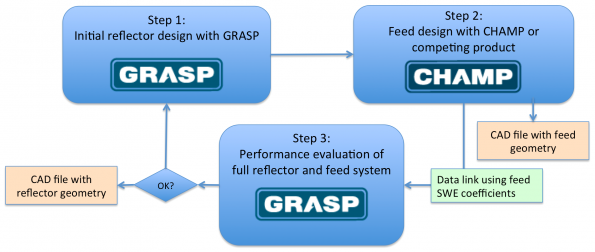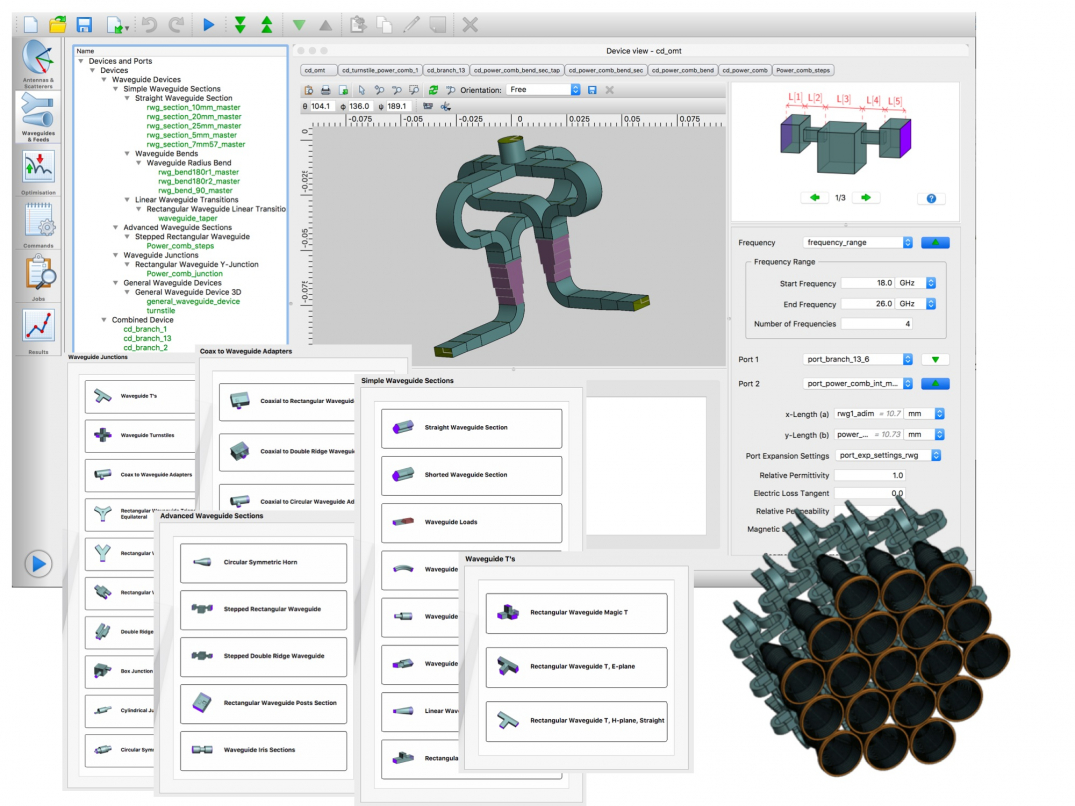
-
StatusCompleted
-
Status date2018-03-28
-
Activity Code5B.159
Reflector antennas are by far the most used antenna technology for telecommunications satellite antennas, ground station antennas, and high-gain user terminals. High-performance reflector antennas are typically designed using the well-established and validated antenna design tool, GRASP, which provides an accurate RF analysis of the isolated reflector antenna. Recently, GRASP was further enhanced with powerful analysis capabilities for assessing platform scattering and antenna interference. However, GRASP does not allow the reflector feed and other feed chain components to be analysed. As a consequence, the antenna designer must design the feed chain in a separate feed design tool, e.g., CHAMP, or a competing tool. Subsequently, the performance of the entire antenna system is evaluated by using GRASP again. This error-prone multi-tool design process is illustrated in the figure below.

The objective of the present activity is to develop a single software tool that allows an end-to-end RF design of advanced reflectors and feed chains, including simultaneous optimization of all parts.
The key challenge in this project is the development of fast RF prediction models that allow reflectors and feed chains to be analysed simultaneously. The fast solution methods must provide very high accuracy to fulfil the requirements of the space industry.
The combination of GRASP and the new add-on product offers a single-tool solution for RF design of advanced reflectors and feed chains. This simplified design process is illustrated in the figure below.

The single-tool solution offers two distinct advantages:
- Today, the typical design goals when optimizing feed systems include the feed beam width, the phase centre stability, and other goals related to the feed radiation pattern. However, these parameters are not performance parameters of the final antenna system. By using a single software tool with simultaneous optimization of reflectors and feeds, the feed radiation pattern is no longer an optimization goal since the performance of the feed system can be measured directly on the secondary pattern performance. This leads to better performance of the final antenna system, because the optimizer can find a better compromise between all system parameters, when intermediate feed performance parameters are no longer important.
- Using a single RF design tool simplifies the design process, thereby reducing engineering labour and providing a shorter time-to-market. At the same time, the risk of errors is reduced
The new add-on product contains a collection of fast and accurate RF analysis methods, including modal analysis algorithms for many of the components used in modern feed chains. At the same time, more general solvers are included for characterizing arbitrary waveguide components where a modal analysis is not available. The most appropriate solver can then be chosen for each component, and a rigorous RF model of a complex feed chain is built by using a generalized scattering matrix framework. A library of the most commonly used waveguide components is included to facilitate an easy problem definition and to provide a fully parameterized model of a feed chain. In addition, the new add-on includes powerful optimization features with a seamless integration into GRASP. The combination of the advanced reflector modelling capabilities in GRASP and the new add-on product offers a software tool with unique capabilities.

The new add-on product will be fully integrated into the existing GRASP software and the modular approach ensures a pleasant user experience for customers with licenses for both GRASP and the new product. The new analysis capabilities are built into the GRASP back-end which also allows batch runs of large problems. In addition, a new dedicated part of the GRASP graphical user interface is available for easy definition of complex feed chains.
The project plan is divided into two parts. The electromagnetic models and the back-end software module are developed in the first part and an easy-to-use graphical user interface is developed in the second part. In both cases, the new software is integrated directly into the existing GRASP software. Validation using realistic use cases is performed before completion of the activity.
The project has been completed.
SUMMARY
A new add-on product to the GRASP software has been developed. The add-on contains Feed Systems Modelling, Optimisation capabilities, and dedicated work spaces in the Graphical User Interface (GUI) for handling these new features. The added features are integrated seamlessly with the existing commercially available GRASP software.
The new software allows direct and simultaneous optimisation of reflector and feed systems. This avoids the error-prone data exchange between two separate software tools. Further, the direct optimisation approach implies that entire feed chains can be optimised in their final operational environment, i.e, in front of the reflector. This capability is expected to lead to improved performance of advanced telecommunication reflector antenna payloads.


